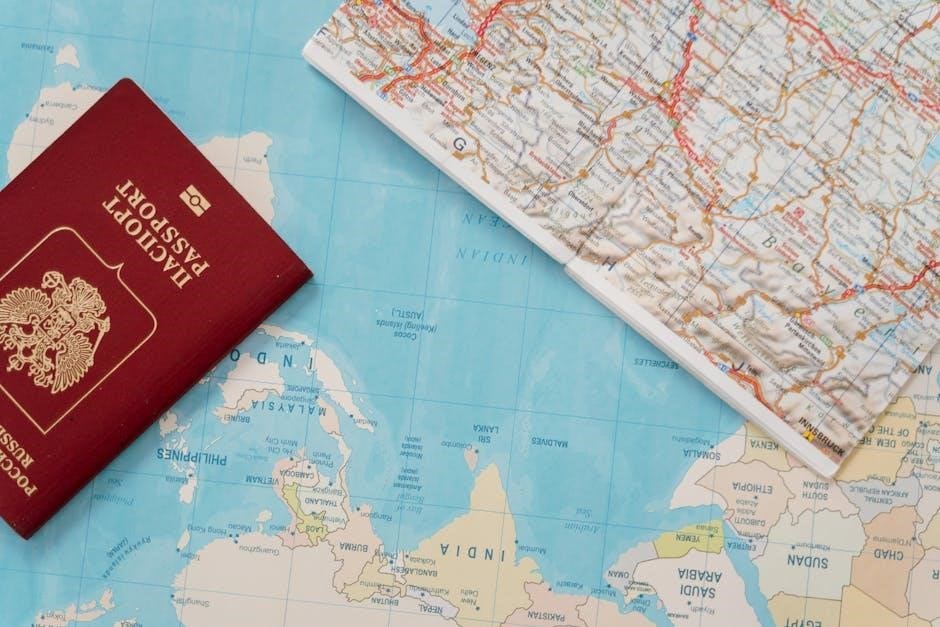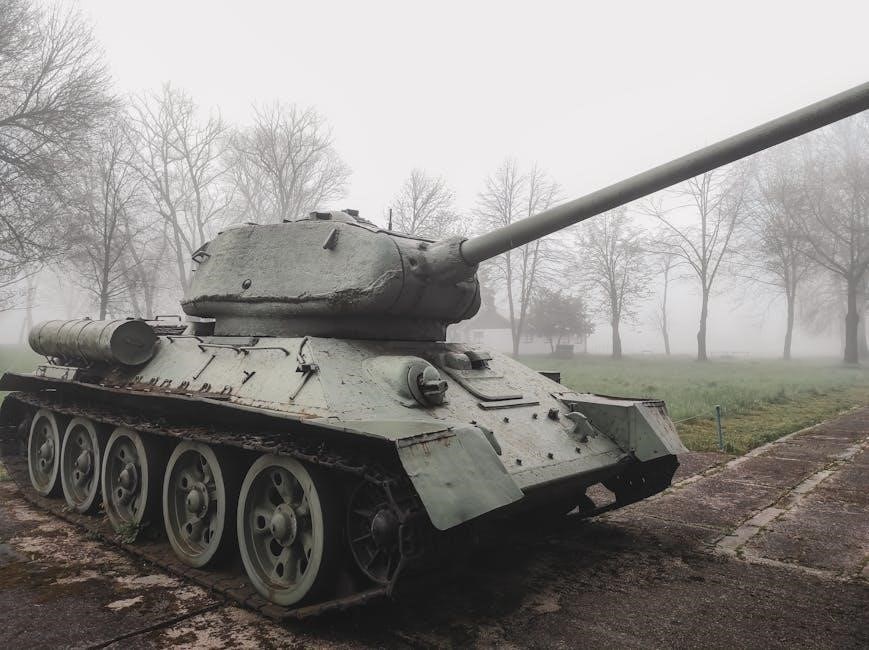Historical Context of World War I
World War I began in 1914, with Russia allied with Britain and France against Germany and Austria-Hungary. Russia’s involvement led to significant economic strain and military losses, ultimately contributing to widespread unrest among its population, which played a crucial role in the subsequent Russian Revolution.
1.1. Assassination of Archduke Franz Ferdinand
The assassination of Archduke Franz Ferdinand on June 28, 1914, in Sarajevo, Bosnia, was the immediate trigger for World War I. Gavrilo Princip, a Serbian nationalist, carried out the assassination, aiming to unite South Slavs under Serbian rule. This act sparked a chain reaction among European powers, leading Austria-Hungary to issue an ultimatum to Serbia. The complex system of alliances and rising tensions between nations escalated the conflict, drawing in major powers like Germany, Russia, France, and Britain. The event marked the beginning of a global war that would reshape the world order.
1.2. Role of Militarism and Imperialism
Militarism and imperialism were significant factors leading to World War I. European nations engaged in an arms race, glorifying military power and competing for colonial territories. Imperialism fueled tensions as countries sought resources and influence globally. This competition for dominance created rivalries, particularly between Britain and Germany. The complex system of alliances, amplified by militaristic policies, made even minor conflicts potentially explosive. These forces, combined with nationalist sentiments, set the stage for the war’s outbreak, as nations prioritized expansion and security over diplomacy and cooperation.

Causes of World War I
The complex system of alliances, rising nationalism, and imperialist rivalries created tensions among European powers. The assassination of Archduke Franz Ferdinand ignited these simmering conflicts, leading to war.
2.1. System of Alliances
The system of alliances before World War I divided Europe into two opposing groups: the Triple Entente (France, Britain, Russia) and the Triple Alliance (Germany, Austria-Hungary, Italy). These alliances created a complex web of mutual defense agreements, heightening tensions and making it difficult to isolate conflicts. When Austria-Hungary declared war on Serbia, the alliances triggered a chain reaction, drawing more nations into the war. This rigid system of alliances left little room for neutrality or diplomacy, ultimately escalating the conflict into a global war. The inflexible nature of these alliances made peaceful resolution nearly impossible.
2.2. Nationalism and Ethnic Tensions
Nationalism and ethnic tensions played a significant role in the lead-up to World War I. Across Europe, rising nationalist sentiment fueled competition among nations, with many seeking to assert their dominance or protect their interests. The complex ethnic makeup of empires like Austria-Hungary and the Ottoman Empire further destabilized the region. Ethnic groups within these empires, such as Serbs and Arabs, sought greater autonomy or independence, creating tensions that aligned with broader nationalist movements. These competing identities and ambitions contributed to the volatile atmosphere that ultimately led to the outbreak of war.

Key Events of World War I
World War I began with the assassination of Archduke Franz Ferdinand, triggering a chain reaction of military alliances and conflicts. Trench warfare dominated the battlefields, while events like the Battle of the Somme and Verdun highlighted the war’s brutality; The U.S. entered in 1917, shifting the war’s balance, and the Armistice of 1918 ended hostilities.
3.1. Trench Warfare and Major Battles
Trench warfare defined World War I, as soldiers on both sides endured brutal conditions in deep, muddy trenches. Battles like the Somme and Verdun became infamous for their relentless artillery, massive casualties, and minimal territorial gains. These confrontations highlighted the futility of traditional military tactics against modern weaponry. The stalemate in trench warfare prolonged the conflict, leading to widespread despair and exhaustion among troops. The harsh conditions and constant bombardment took a devastating toll on soldiers’ physical and mental health, emphasizing the war’s industrialized and impersonal nature.
3.2. Entry of the United States
The United States initially maintained neutrality in World War I, focusing on domestic issues and avoiding involvement in European conflicts. However, several factors led to its entry in 1917. Germany’s resumption of unrestricted submarine warfare, which targeted neutral shipping, including American merchant ships, was a major catalyst. The sinking of the passenger ship Lusitania in 1915, killing over 1,000 civilians, including 128 Americans, outraged public opinion. Additionally, Germany’s attempt to ally with Mexico against the U.S., revealed in the Zimmermann Telegram, further pushed the U.S. toward war. Economic ties with the Allies and President Wilson’s idealistic stance on democracy also influenced the decision. The U.S. entry marked a turning point in the conflict, providing crucial support to the Allies and shifting the war’s dynamics.
3.3. Treaty of Versailles
The Treaty of Versailles, signed on June 28, 1919, officially ended World War I. The agreement imposed harsh penalties on Germany, including significant territorial losses and heavy reparations, under the controversial “War Guilt Clause.” The treaty aimed to establish a new international order, with the creation of the League of Nations to prevent future conflicts. However, its punitive measures fueled widespread resentment in Germany, contributing to economic instability and the rise of nationalist sentiment, which would later play a role in the lead-up to World War II.

The Russian Revolution
The Russian Revolution began with widespread unrest due to economic strain and military losses during World War I, leading to the abdication of Tsar Nicholas II and the rise of the Bolsheviks.
4.1. February Revolution and Abdication of the Tsar
The February Revolution of 1917 began with mass protests in Petrograd, driven by food shortages and economic hardship exacerbated by World War I. Demonstrations turned violent, and the Russian army joined the protesters, leading to the collapse of Tsar Nicholas II’s authority. On March 15, 1917, the Tsar reluctantly abdicated, ending the 300-year Romanov dynasty. This marked the end of imperial rule and paved the way for a provisional government, creating a power vacuum that Bolsheviks would later exploit.
4.2. October Revolution and Bolsheviks
The October Revolution, led by the Bolshevik Party under Vladimir Lenin, overthrew the provisional government in November 1917. This socialist group, representing the radical interests of the lower classes, seized power during the political chaos following World War I. The revolution marked the establishment of the world’s first socialist state, with Lenin at its helm. It followed the February Revolution, which had removed Tsar Nicholas II, creating a power vacuum the Bolsheviks exploited to reshape Russia’s political landscape and pave the way for the Soviet Union’s formation.
4.3. Russian Civil War
The Russian Civil War (1917–1922) erupted after the Bolsheviks seized power, pitting the Red Army, led by the Bolsheviks, against the White Armies and other anti-Bolshevik groups. The conflict arose from opposition to Bolshevik rule and their radical policies. The Whites, supported by foreign powers, sought to restore the monarchy or establish a democratic government. The Red Army, organized by Leon Trotsky, ultimately prevailed, solidifying Bolshevik control and leading to the establishment of the Soviet Union in 1922. The war caused immense suffering and shaped Russia’s future under communism.

Connection Between World War I and the Russian Revolution
World War I caused severe economic strain and political unrest in Russia, leading to the collapse of the Tsar’s regime and the rise of the Bolsheviks.
5.1. Economic Strain and War Effort
Russia’s involvement in World War I exacerbated economic strain, as the country was unprepared for the war’s demands. Military losses and resource depletion led to inflation and food shortages, worsening living conditions. The war effort drained the economy, causing widespread poverty and discontent among the population. Economic policies failed to address these issues, further alienating the working class and peasantry. This financial crisis weakened the Russian Empire, creating fertile ground for revolutionary movements and ultimately contributing to the collapse of the Tsarist regime.
5.2. Political Unrest and Rise of Bolshevism
Russia’s involvement in World War I deepened political unrest, as military defeats and economic hardship eroded public trust in the Tsarist regime. The Provisional Government, established after the February Revolution, struggled to maintain stability amid ongoing war efforts and societal discontent. This power vacuum enabled the Bolsheviks, led by Vladimir Lenin, to capitalize on widespread frustration. Lenin’s promises of “Peace, Land, and Bread” resonated with the war-weary population, facilitating the Bolsheviks’ rise to power during the October Revolution and reshaping Russia’s political landscape.

Impact of World War I
World War I caused unprecedented loss of life, widespread destruction, and profound economic strain. It reshaped global politics, leading to the collapse of empires and widespread social change.
6.1. Social and Political Changes
World War I sparked significant social and political transformations globally. The war accelerated women’s suffrage movements, as women took on new roles in the workforce. Politically, the collapse of empires like the Ottoman and Austro-Hungarian led to the redrawing of national boundaries. The war also fueled the rise of revolutionary movements, including Bolshevism in Russia, which capitalized on widespread discontent. Additionally, the economic strain and massive casualties eroded public trust in governments, leading to widespread protests and demands for reform. These changes laid the groundwork for the interwar period’s instability and the rise of new ideologies.
6.2. Economic Consequences
World War I left a devastating economic impact globally. European economies were severely strained due to massive war debts, with nations like Britain and France facing long-term financial instability. The war disrupted global trade, leading to inflation, unemployment, and food shortages. Russia’s economy collapsed under the strain of war efforts, contributing to the revolution. Post-war, Germany faced crippling reparations, leading to hyperinflation and economic ruin. The global economy became increasingly interconnected, but the war’s aftermath also sowed seeds of economic instability that lingered for decades, affecting recovery and growth.

Impact of the Russian Revolution
The Russian Revolution led to the establishment of the Soviet Union, the world’s first socialist state, and inspired global communist movements, reshaping 20th-century geopolitics.
7.1. Establishment of the Soviet Union
The Russian Revolution culminated in the October Revolution, where Bolsheviks, led by Lenin, seized power, ending the provisional government. This led to the formation of the Soviet Union in 1922, following the Russian Civil War. The new state was founded on Marxist-Leninist principles, establishing a one-party communist system. The Soviet Union became a global superpower, influencing international relations and spreading communist ideologies worldwide, while internally implementing radical social and economic changes that reshaped Russian society forever.
7.2. Global Spread of Communism
The Russian Revolution inspired socialist movements worldwide, sparking a wave of Marxist-Leninist ideologies across Europe, Asia, and beyond. The Bolsheviks’ success encouraged the formation of communist parties globally, particularly in China and Eastern Europe. This led to the rise of socialist states after World War II, fueled by the Cold War rivalry between the Soviet Union and Western powers. While many communist governments eventually declined, the revolution’s legacy endured, shaping global politics and leaving a lasting impact on international relations and ideological conflicts in the 20th century.

Legacy of Both Events
World War I and the Russian Revolution profoundly shaped the 20th century, led to the rise of Soviet Union, World War II, and Cold War.
8.1. World War I and Interwar Period
World War I’s end marked a tumultuous interwar period, with the Treaty of Versailles imposing harsh penalties on Germany, fueling economic hardship and political instability. The war’s aftermath saw the rise of fascism in Italy and Germany, while communism gained traction in Russia. Economic struggles, such as hyperinflation in Germany, created fertile ground for extremist ideologies. The interwar period also witnessed failed attempts at collective security, setting the stage for World War II. These events underscored the deep societal and political fractures left by the Great War.
8.2. Russian Revolution and Cold War

The Russian Revolution’s aftermath established the Soviet Union, a communist state that opposed Western capitalism. This ideological divide intensified during the Cold War, as the USSR sought to expand communism globally. The revolution’s legacy shaped decades of geopolitical tension, influencing proxy wars, the arms race, and the formation of alliances like NATO and the Warsaw Pact. The clash between Soviet communism and Western democracy defined global politics for nearly a century, leaving a lasting impact on international relations and modern history.
